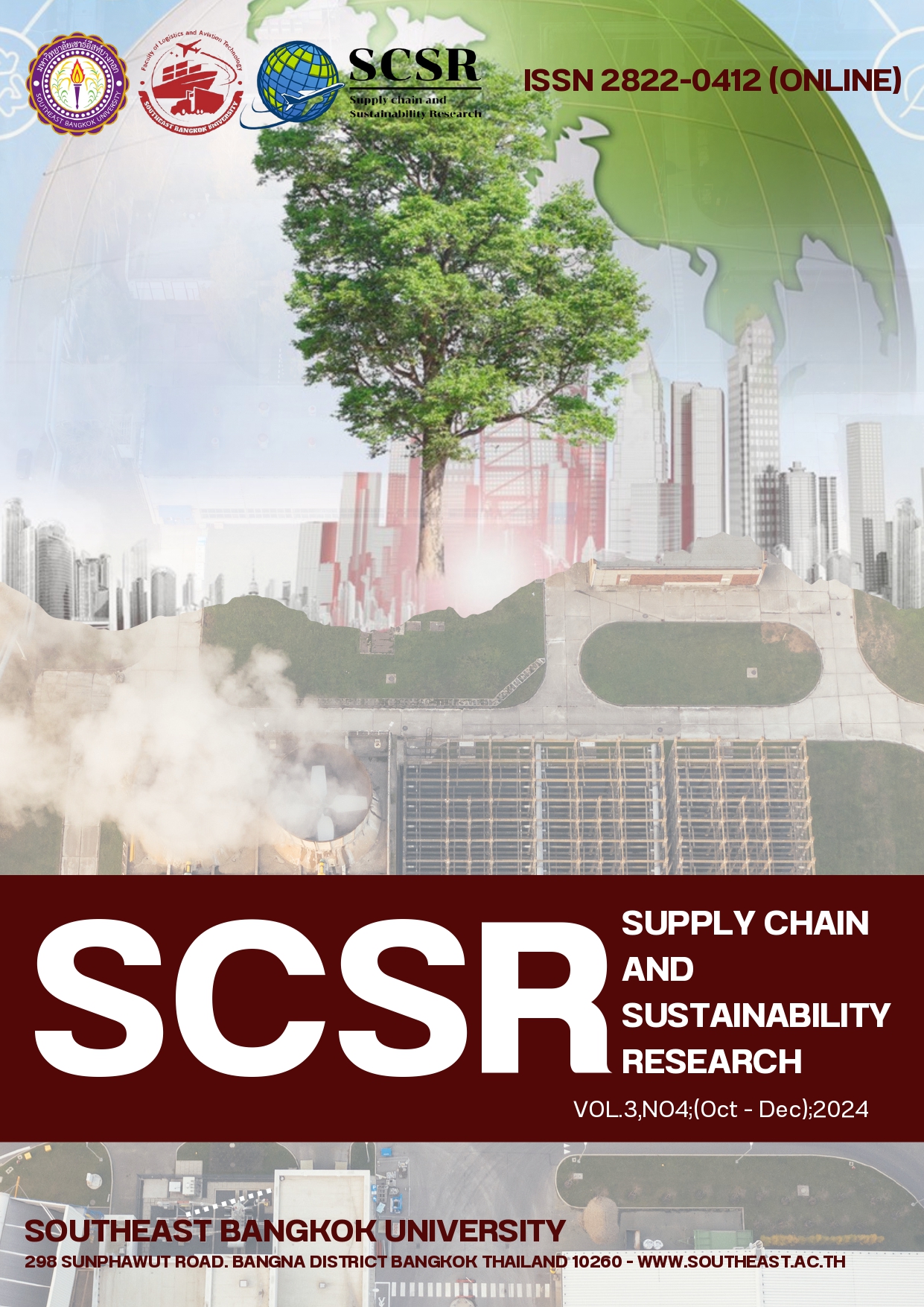Climate Change, Natural Disasters, and Sustainable Water Resources Management in the Lancang-Mekong River Basin
Main Article Content
Abstract
The Lancang-Mekong River Basin stands as the largest river basin in Southeast Asia, spanning across riparian states including China, Laos, Myanmar, Thailand, Cambodia, and Vietnam. In light of this significance, the Third Lancang-Mekong Cooperation Leaders' Meeting took place on August 24, 2020, aiming to foster consensus among these nations. However, despite such agreements, the region continues to face various disasters, including droughts, floods, and dam collapses, resulting in substantial damages.
This research endeavours to investigate the historical context of the Lancang-Mekong River Basin, focusing on water resources management within the area. By employing the perspectives of information sharing and coexist environment theory, the study aims to shed light on effective strategies for addressing these challenges. Through an examination of past practices, this research seeks to provide valuable insights into managing water resources in the Lancang-Mekong River Basin, promoting sustainable development and fostering cooperation among the riparian states.
Article Details

This work is licensed under a Creative Commons Attribution-NonCommercial-NoDerivatives 4.0 International License.
Supply Chain and Sustainability Research uses a Gold Open Access model. All articles at Supply Chain and Sustainability Research are published Open Access. Publication is funded by a fee paid at the time of acceptance (Publication Fee). From June 2020 onward, author(s) retain copyright of their work, with articles licensed to the publisher Southeast Bangkok College and Supply Chain and Sustainability Research. All articles published on this site use the Creative Commons Attribution 4.0 License (CC BY 4.0). You do not need to seek permission from Supply Chain and Sustainability Research or Southeast Bangkok College for reuse of contents published on this site.
This means;
All articles are immediately available free-of-charge upon publication.
Copyright on all Open Access articles in Supply Chain and Sustainability Research is retained by the author(s), or the author's Employer.
Author(s) grant Southeast Bangkok College a license to publish the article and identify itself as the original publisher.
Author(s) also grant any third party the right to use the article freely as long as its integrity is maintained and the original authors, citation details and publisher are identified.
You are free to:
Share — copy and redistribute the material in any medium or format
Adapt — remix, transform, and build upon the material for any purpose, even commercially.
Under the following terms:
Attribution — You must give appropriate credit, provide a link to the license, and indicate if changes were made. You may do so in any reasonable manner, but not in any way that suggests the licensor endorses you or your use.
No additional restrictions — You may not apply legal terms or technological measures that legally restrict others from doing anything the license permits.
There may be exceptions to copyright and licensing for articles which were previously published under policies that are different from the above, in this case different licensing conditions may then apply. If in any case Supply Chain and Sustainability Research contains material republished with permission under a different license, you may need to seek permission for reuse from the copyright holder. In all such cases, however, access to these articles is free from fees or any other access restrictions.
Open Access ensures the widest possible access to research, makes research available to wider audiences, allows readers to use articles and data, and also allows author(s) to distribute their works freely. Open Access accelerates research by removing barriers to collaboration and accelerates scientific communication.
If you require more information, please don't be hesitated to contact the Editorial team anytime here or contact the Editorial Office below.
References
Basist. A., & Williams, C. (2020). Mekong River Wetness Anomalies in the 2019 Monsoon Season. Eyes on Earth.
BBC. (2018). China’s Geopolitical Power and the Mekong Ecological Holocaust. BBC Chinese Version, 14. August.
BBC (2015). Climate Change: Mekong Delta heads for troubled waters. Retrieved date: 24/02/2025. Website: https://www.bbc.com/news/science-environment-34407061.
Beech, H. (2020). China Builds Dams to Restrict the Flow of. the Upper Mekong River, Causing Drought in Many Countries Downstream. New York Times Chinese Version, 14. April.
Bowen, G. (2009). Document Analysis as a Qualitative Research Method. Qual. Res. J., l9 (2), 27.
Campbell, I. (Ed). (2009). The Mekong Biophysical environment of an International River Basin. Elsevier.
Godoy, O. (2019). Coexistence theory as a tool to understand biological invasions in species interaction networks: Implications for the study of novel ecosystems. Functional Ecology, 33(7), 1190-1201.
Grunwald, R. (2020). Lancang Mekong Cooperation: Present and Future of the Mekong River Basin. Journal for Political Science, Modern History, INT. REL., Secur Stud, 23 (2), 69.
Hung, T. (2020). The Latest Research shows that the Dam Construction of China in Mekong River Basin has influenced 60 million population lack of water. Newtalk, 14. April.
Inclusive Development International (2025). Laos: Demanding accountability for deadly dam collapse. Retrieved date: 24/02/2025. Website: https://www.inclusivedevelopment.net/cases/laos-xe-pian-xe-namnoy-dam-collapse/
Medium (2020). Malawi’s 350MW Hydropower Project Reaches Major Milestones in 2019. Retrieved date: 24/02/2025. Website: https://medium.com/power-africa/malawis-350mw-hydropower-project-reaches-major-milestones-in-2019-4f19ea7973f2
Ouyang, S. (2016). Vietnam Requests China for Releasing. Water from Dam? The Situation in Lancang (Mekong) River Basin. KKnews, 16. March. Peninsula. The water level of lower Mekong river reached the lowest level in the past 50 years. The News Lens, 15. April.
Rafaeli, S. & Raban, D. (2005). Information Sharing Online: A research challenge. Int. J. Knowl. and learn., 1 Nos.1/2, 62.
Reuters. (2020). Chinese dams held back Mekong waters during drought, study finds. Retrieved date: 24/02/2025. Website: https://www.reuters.com/article/world/chinese-dams-held-back-mekong-waters-during-drought-study-finds-idUSKCN21V0U1/
Stimson. (2021). Mekong Dam Monitor. Stimson.
The News Lens. (2020). The Dam Construction of China occurs drought in Indochina.
Tiezzi, S. (2020). China, Southeast Asia Leaders Meet to Discuss the Mekong’s Plight. The Diplomat, 25. August.
Tsai, M. (2020). Dam, dam, dam! Then the Mekong River Disappears? Discussion about ‘International Water Law’. Crossing, 19 June.
Wu, W. (2020). China Control Upstream Mekong River and. Drought Downstream Countries. Epoch time, 15. April.
Xiao, C. (2020). Neighbors in Southeast Asia are Ignored: Building Dams causing water shortage and droughts in downstream countries. Musou, 23. April.

